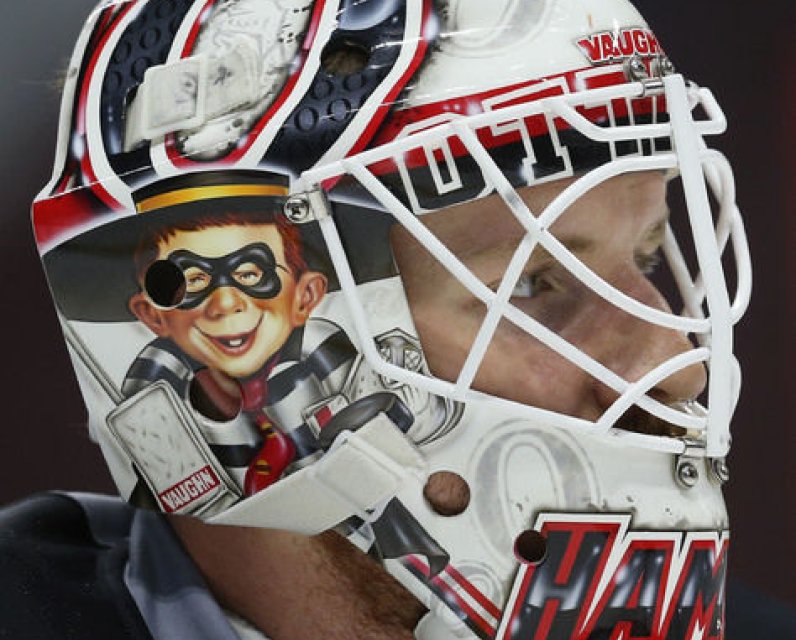Unpublished Opinions
I am the founder of Unpublished Media Inc., a company I started in 2012. I am also a communications professional and community activist, living in Nepean, Ontario. And, I am a hockey goaltender, political hack and most importantly, an advocate for grassroots, participatory democracy at all levels of government.
Hamburgerling: How it's done

Andrew Hammond's incredible run in the Ottawa Senators' net is no accident. The 27 year old rookie has lead the Sens with a 16-1-1 record since coming in to relieve Robin Lehner in mid-February.
Hammond is a product of Canada's Junior Hockey system. A goalie who earned every opportunity to move one step closer to his dream the hard way. A journey that began in Junior B, a level I know well.
I can't speak for him, but my recollection of Junior B includes tough hockey games with knock 'em out' 'drag him off' fights on the ice and in the stands among supporters--all kind of craziness in the last year of the Cape Breton Junior B league where I tended goal for the Antigonish Bulldogs in the winter of 1985-86. I doubt Hammond's experience was any different. Such is the way of Junior hockey in Canada.
After quitting hockey for 3 weeks, Hammond recommitted to pursuing his dream, eventually leading his Junior A Tier II team to two National Championships. His success at that level, no small feat, lead to a scholarship at Bowling Green University in the United States. He signed with the Senators last year and moved up the ranks to take over the number one job in Binghamton this year.
Despite a slow start in Binghamton, Hammond has shown that he knows how to tend goal. He's not as flashy as Robin Lehner or as quick as Craig Anderson. Nevertheless, he keeps the puck out. Enough to allow his team to stage one of the best late season pushes for a playoff position we've seen in a while, and to earn him NHL player of the Month honours in March.
So how does a seemingly less talented goaltender have the Senators playing their best hockey since they gave the boot to the Habs in the first round of the 2012-13 playoffs? I believe it's because Hammond respects the golden rules of goaltending. Combined with solid technique, Hammond is able to maximize his ability and potential by adhering to the 5 key principles that all great goalies share.
Rule #1: Stay square to the puck
Andrew Hammond is succeeding where Anderson and Lehner have not because he is very good at keeping square to the puck no matter where he is in the net.
I explain it to young goalies the same way it was explained to me... At all times, you should be able to draw a line from the centre of the net to the puck, that passes directly between the goalie's legs. If you can keep this imaginary line always running through the centre of your body, you will have a much easier time stopping pucks. Why? Geometry. If a goalie is playing their angles, a player has a lot less of the net to shoot at. If they do shoot, they will either hit the goalie or miss the net, 9 time out of 10.
Standing at the top of your crease and playing your angles well, forces players to pass off and make lower percentage plays in order to get a shot on net. As a smaller goalie, this was my key to success. Hammond also does it extremely well. He's not as flashy as some goalies because he doesn't have to be. Always being in the right position means you don't have to flop and flay around in the crease to make saves. It helps reduce stray rebounds and ensures you have a better chance of stopping shots #2 and 3 if they happen.
Rule #2: Don't move until the shooter moves
I'm not a fan of the new style of goaltending that sees goalies on their knees before a shooter decides what to do. This style, I dub the 'Carey Price' style of goaltending, is based more on blocking shots rather than actually making saves. It claims to play the percentages, in that if you block off the bottom of the net you are more likely to make a save.
But, it contradicts a golden rule of goaltending that has served goalies well from the beginning. If you are on your knees before a shooter shoots, he can go over your shoulder easily. If he does, there isn't much you can do about it. However, if you remain standing until you know what play is going to be made, you have a better chance of ensuring the shot will be low. You can then move with confidence to make the save. There's a reason 'Down and Out (of the play)' is a hockey expression.
Why is this important? Because if you are down before the shot comes, you can't make a real goaltending save, I.e. You can't control the rebound as well, not too mention cover off the top of the net. Yes, it's easier to handle wrap arounds but any NHLer worth is salt can roof the puck when he needs too. There's a reason 'Down and Out (of the play)' is a hockey expression.
Carey Price didn't become the goalie he is this year until he learned the difference between blocking and stopping pucks at the Olympics last year. He was forced to up his game against the best in the world if Canada was going to win a Gold Medal. Fortunately he did. And still, at times, he reverts back to his old ways, as he demonstrated in Ottawa's 5-2 shallacking of the Habs a couple weeks ago.
Have you noticed how well Hammond controls his rebounds? If he isn't gobbling up the first shot then the rebound is dropping at his feet or being deflected into the corner, not bouncing into the slot for a second or third opportunity.
Staying on his feet as long as possible will be very important tonight if Hammond wants to shut down Capitals sniper Alex Ovechkin, who now has 52 goals after lighting the lamp twice against the Habs Thursday night. Ovechkin's 51st was a beauty just under the bar over Price's shoulder.
Rule #3: Take one play at a time
I didn't figure this rule out until after I had retired from playing competitive hockey. Had I been better at keeping my focus and not letting goals get to me, I may have made the NHL!
Anderson was lights out focused two years ago after he returned from a training stint in Florida. I have never seen any goalie that focused and clear of mind and purpose. Unfortunately, he hasn't been able to recapture that focus since his return and has allowed teams to come back late in games. The Sens games vs. the Flames and Leafs games are two example of recent, bad third period collapses that you just can't have at this stage of the season.
I have been impressed with the way Hammond is able to shrug off a goal. He understands that if you seperate every play and every rush into the singular challenge of preventing a goal by making the play, it makes it easier to deal with the odd time one gets past you.
Rule #4: Make saves and control rebounds
Making a good save includes controlling the rebound. In the old days when goalie pads were filled with horse or dear hair, it was easier to get a puck to drop at your feet. I loved my old Brown leather pads I wore in junior despite their weight. While the new pads are light as a feather in comparison, controlling rebounds is far from easy.
I'm impressed by the way Hammond absorbs pucks into his body, smothering rebounds quickly. If and when he does give one up, he directs it out of harms way. Unlike many 'blocking' goalies, Hammond has learned how to 'cushion' a leg pad save so that the rebound is under 'control' at all times. Perfecting this skill takes time and hard work. Something Hammond knows a lot about.
Rule #5 Be a leader
While it's not a golden rule of goaltending, a goaltender who is a leader on the ice and in the dressing room earns the respect of his teammates, and can help a team gel around him. Andrew Hammond has impressed everyone with his friendliness, laissez-faire and calm demeanour. Mark Borowiecki summed it up best when he said Hammond was unusual for a goalie in that he's just a normal guy.



Comments
Be the first to comment